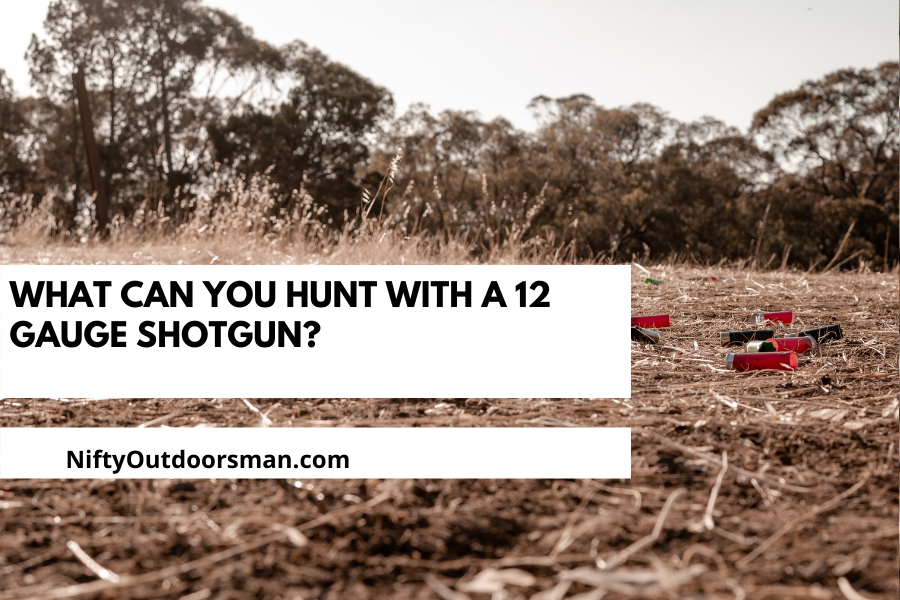12 gauges are often thought of as the most versatile shotgun gauge. And this is true. But just how versatile is it and what all can it take down ethically.
Here is the short answer:
A 12 gauge is one of the most versatile hunting shotgun gauges. If using birdshot you can take down squirrels, rabbits, doves, quail, pheasants, ducks, and geese. When using buckshot you can hunt coyotes, raccoons, opossums, and all varmints. If you are shooting slugs you can hunt almost all big game like hogs, pronghorn, deer, elk, and even moose with a good shot.
Now that you have the short answer, let’s take a closer look at the different types of ammo and how does it compare to different shotgun gauges.
Different types of shotgun ammo
There are a lot of different types of shotgun ammo made for hunting different game, here are the different types and their uses:
Birdshot
The main purpose of birdshot is in the name it is made for birds. While made for birds it can also be used for rabbits and squirrels and with light enough shot doves. Birdshot comes in either lead or steel. Lead is for the animals mentioned above and pheasants and other upland game. Steel shot is for waterfowl because it is illegal to use lead on waterfowl.
There is a lot of size shot for birdshot. The higher the number on the box means the smaller the shot size. The bigger the shot the bigger of animal it can take down but the less shot that is in the shell. Here is the rule of thumb for what shot could kill what animal:
| doves | 9, 8, 7.5, and 7 shot |
| rabbit | 7.5, 7, and 6 shot |
| Squirrel | 7.5, 7, and 6 shot |
| Quail | 9, 8, 7.5, and 7 shot |
| Pheasant | 6, 5, and 4 shot. |
| Ducks | 4, 3, and 2 shot |
| Geese | 3, 2, 1, BB, and BBB shot. |
Turkey shot
Turkey shot is made for turkey as you can guess. Turkey shot is a little different than birdshot as it has more powder. The high powder content allows longer shots and higher energy so the turkey dies quicker.
Here is the recommended shot size for turkeys:
| Turkey | 6, 5, and 4 turkey shot. |
Buckshot
Buckshot can be used for multiple things from hunting to self-defense. Buckshot are big round lead balls that carry a lot of energy. One pellet of 00 buck has almost as much energy as 9mm a popular self-defense handgun caliber. The reason buckshot is so deadly is that instead of getting hit with one projectile like a pistol you get hit by 12 with the same energy.
While buckshot can be used to hunt deer it is not recommended and even illegal in some states. But buckshot works great on coyotes at close range. The downside to buckshot is that it has a limited range of about 50 yards.
| Coyotes | Number 1, 00, and 000 buckshot |
| Raccoon | Number 4, 3, and 2 buckshot. |
| Other varmints | Number 4, 3, 2, 1, and 00 buckshot |
| Self-defense | 00 and 000 self-defense buckshot loads |
Slugs
Shotgun slugs are big pieces of lead that carry a lot of energy. A shotgun slug can weigh as much as one ounce and carry as much as 3000 foot-pounds of energy. Slugs are used for hunting big game such as deer or elk. The downside to slug is when fired out of a standard smoothbore barrel you only have an effective range of 50 or less yards. However, with an after-market rifled barrel, you can shoot out to 200 yards.
For hunting any big game animal you should use rifled hollow point slugs.
12 gauge vs other gauges
There are a lot of different shotgun gauges out there but what makes the 12 gauge better or worse than the others. And what makes it different.
What is a gauge
Before we compare the different shotgun gauges what is a shotgun gauge.
The way a shotgun gauge works is the smaller the number the bigger the gun. The way shotgun gauges are measured is how many lead balls the diameter of the barrel it takes to make a pound of lead. So a 12 gauge means that it takes 12 lead balls the diameter of the barrel to make a pound of lead.
12 vs 20 vs 10 gauge
As mentioned before the smaller the number the bigger the bore of the shotgun. So a 20 gauge is smaller than a 12 gauge and a 12 gauge is smaller than a 10 gauge.
The difference between a 12 and 20 gauge is really how much shot it can hold. A 12 gauge holds 1⅛ of size 7½ shot while a 20 gauge only holds ⅞ of an ounce of 7½. Along with holding more pellets, a 12 gauge has more energy than a 20 gauge. But the 20 gauge has less recoil.
While there are differences between the 12 and 10 gauge they are more subtle than a 12 gauge compared to a 20 gauge. As with the 12 vs 20 gauge, the 10 gauge holds more pellets and has more energy and more recoil. Because it has more energy and pellet it is better for big game than a 12 gauge but worse for small game.
So while the 20 gauge has less energy and is better for small game and a 10 gauge has more energy than a 12 gauge. A 12 gauge is a good middle-of-the-road option.
Downsides to 12 gauge
While the 12 gauge is one of the most versatile of the shotgun gauges is has some downsides.
The first downside is the heavy recoil. A 12 gauge can have as much recoil as a 300 Winchester magnum. This can hurt a small frame shooter and make for a not-so-fun shooting experience.
Not the best for small game. If you are hunting rabbits or squirrels the number of pellets that impact the animal can destroy the meat. It may be a better idea the hunt with a 22lr or 20 gauge for small game.
Conclusion
The 12 gauge is very versatile and can kill most game animals in North America. The 12 gauge is one of the best shotgun gauges of all time. It is just a good all-around gauge and comes in many different types of loads from slugs to birdshot.
See more blogs on the effectiveness of other rounds here

